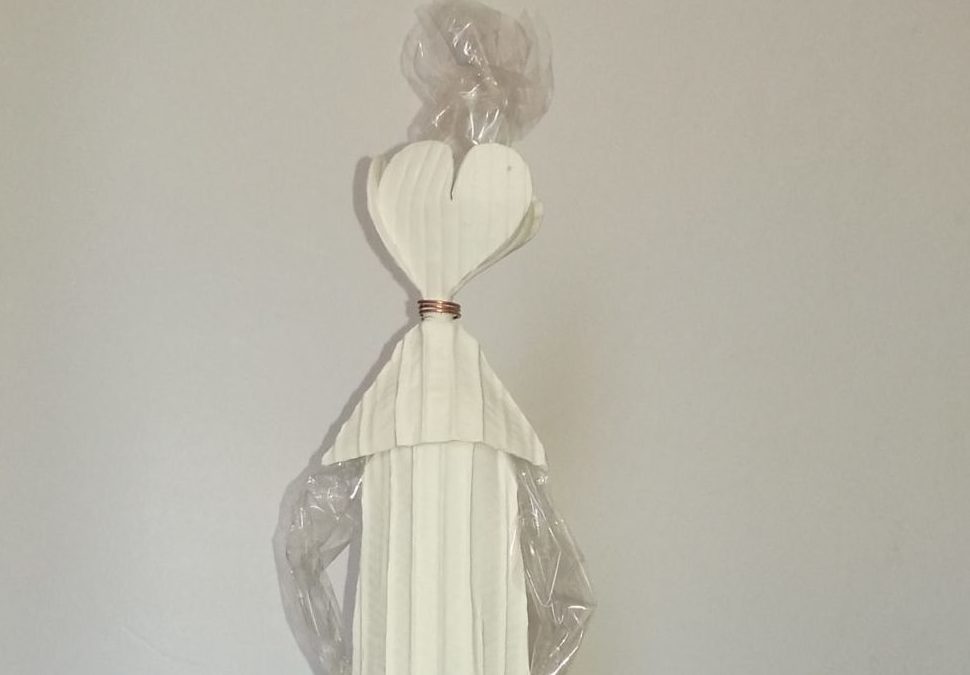
Tulip Lady stage 2
Continuo a lavorare sulle Ladies, voglio dar forma e voce a tante donne,alle tante donne che sono in me, al loro cuore, ai loro capelli che esprimono personalita’, problemi, affanni, seduzione e cambiamenti. Peccato che siano sempre un po’ elettrizzati, ma non ci si puo’ stupire.
Come tante Mafalde di Quino, cresciute, che continuano ad essere cosi preoccupate per le sorti del mondo che i capelli stanno loro tuttora dritti in testa.
La maggior parte del lavoro tuttavia si concentra sul corpo che e’ in porcelain paperclay. In queste ultime Ladies ho utilizzato stampi e sagome di cartone per associazione di materiale, praticita’, leggerezza e sostenibilita’.
La paperclay e’ un miscuglio di argilla e polpa di carta, si puo’ ottenere con diversi tipi di argilla e diversi tipi di carta, riciclata, carta di giornale, carta straccia ecc.
Si possono usare tutte le argille e a seconda del tipo di argilla che si usa si avra’ un diverso prodotto ceramico.Si prepara allo stato liquido, dopo che la carta e’ stata ridotta in polpa e la si utilizza sia allo stato liquido che plastico; in tal caso e’ necessario togliere l’acqua al composto.E’ un materiale economico e resistente soprattutto allo stato crudo. Dopo la cottura invece diminuisce la sua resistenza in rapporto alla quantita’ di carta che e’ stata aggiunta.
L’aspetto che piu’ mi ha sedotto della paperclay e’stata la sua leggerezza, perche’ sia allo stato crudo che cotto si possono ottenere spessori sottili e siccome durante la cottura la carta brucia, l’opera si alleggerisce .

Tulip Lady stage 3
Altro aspetto straordinario e’ la versatilita’ perche’ la si puo’ lavorare in tempi assai piu’ elastici del classico processo della ceramica. Per esempio si possono assemblare diverse parti di un’opera allo stato secco, o riportarla dallo stato secco allo stato plastico, cose impensabili col metodo tradizionale, oppure si puo’ forzare l’ essicazione riducendo il rischio di rotture, inoltre sopporta facilmente l’applicazione del colore o dello smalto in prima cottura.
E’ un materiale nato circa a meta’ del secolo scorso e ha aperto notevoli possibilita’ creative al mondo dell’arte, sia in ambito ceramico che non, riducendo i tempi di lavorazione e bypassando la ricerca a volte complessa di laboratori e forni per ceramica.
Non avevo mai usato la porcellana, il mio primo approccio e’ stato con la paperclay e devo dire che lo trovo un materiale piacevolissimo, vi si concentrano purezza, resistenza, leggerezza.
I keep working on the Ladies, I want to give shape and voice to many women, to the many women who are in me, to their heart, always present, to their hair that express personality, problems, stress, seduction and changes. Too bad they are always a bit electrified, but it’s nothing to be surprised about.
Like many Quino’s Mafaldas, grown up, who keep on being so preoccupied with the future of the world that their hair can’t help but stand on end.
The majority of my work on them focuses on the body which is in porcelain paperclay. In these last ladies I utilized cardboard molds and outlines for similarity of material, practicality, lightness and sustainability.
Paperclay is a mix of clay and pulp of paper, it can be obtained with different types of clay and paper, recycled, newspaper, scrap paper etc.
All types of clay can be used, and depending on the type being used a different ceramic product will come out.
It is prepared at the liquid state, after the paper has been transformed in pulp and it is used both at the liquid and plastic state; in which case it is necessary to take the water out of the mix.
It is an economical material and particularly resistant at its crude state. After cooking its resistance decreases based on the amount of paper that was added to the compound.
The aspect of paperclay that seduced me the most is its lightness, because both at its crude and cooked states it is possible to obtain sculptures that are very thin, and since the paper burns out after cooking, the whole sculpture becomes lighter.
Another extraordinary aspect of paperclay is its versatility, because it’s possible to work on it within much more dilated times compared to the common ceramic process. For example, it’s possible to assemble different parts of an opera at the dry state, or bring it back from the dry state to the plastic state, which is unimaginable with the traditional method. Otherwise, it is possible to force the exsiccation reducing the risk of cracking, and it ultimately easily supports the application of color or glaze at first cooking.
It is a material that was born around the middle of last century and it has opened to the art world various creative possibilities, both in the ceramic realm and not, reducing production times and bypassing the often complex research for laboratories and ceramic kilns.
I had never used porcelain, my first approach has been with paperclay and I have to admit that I find a highly pleasant material, a concentration of purity, resistance, lightness.

